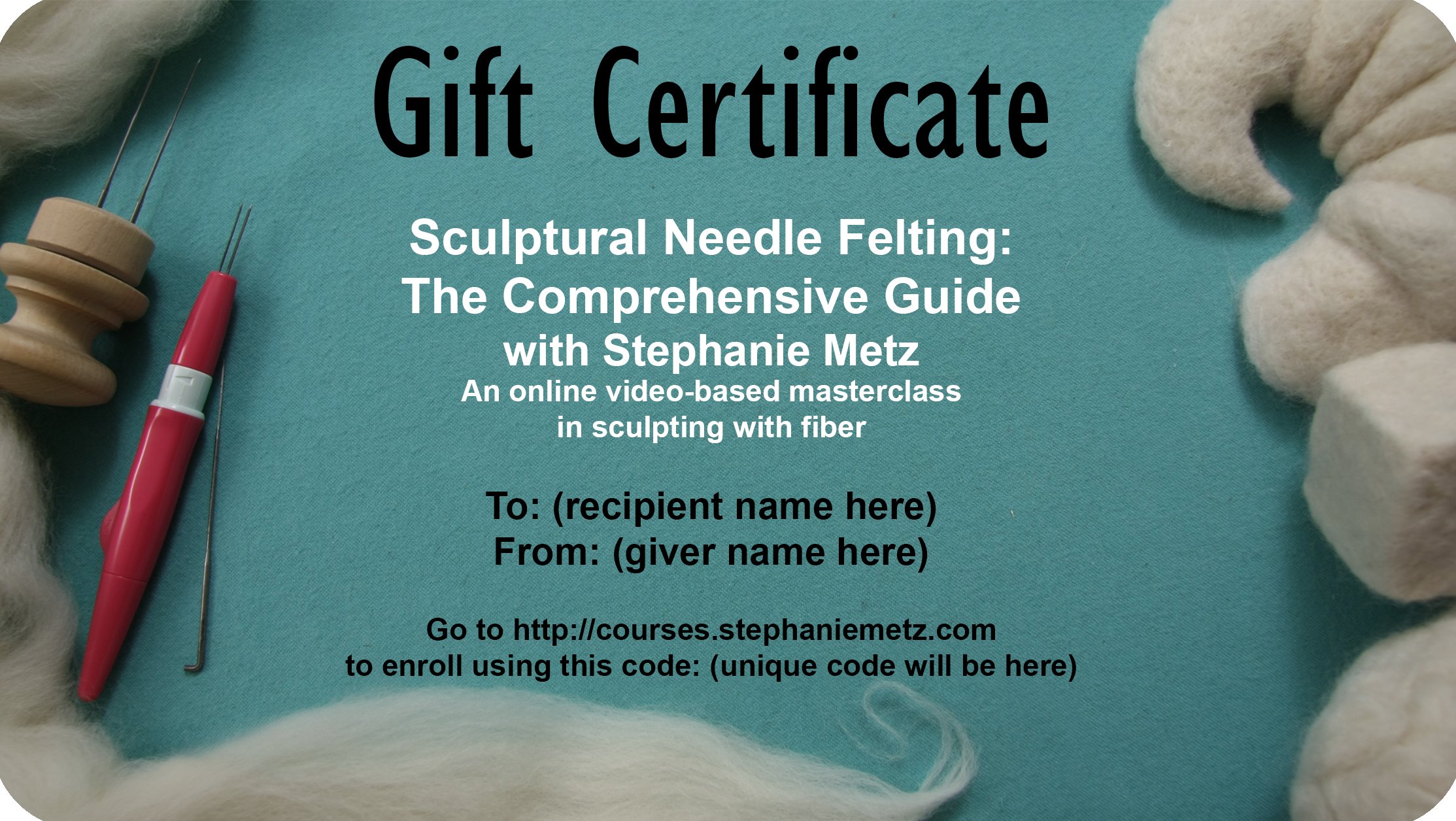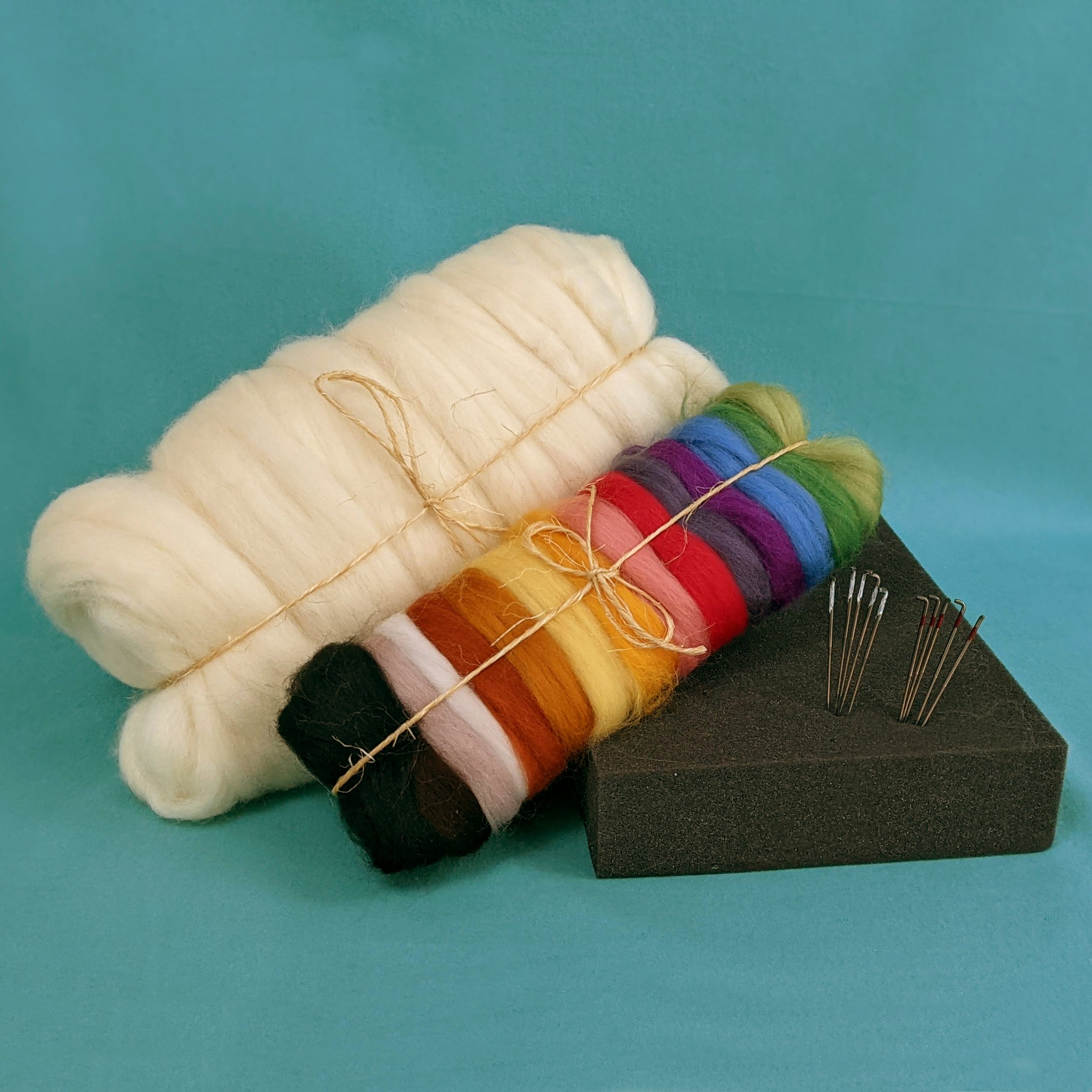Learn Sculptural Needle Felting with Stephanie Metz
There is nothing quite like learning in person: the interactions with a skilled instructor, a front-row seat to demonstrations, the hands-on experience, and the chance to get direct feedback and answers to your particular questions. I truly love teaching students about sculptural needle felting. Twenty years in I’m still dazzled by the fact that one can poke at wool fibers with sharp, notched needles and create three dimensional forms.
My approach is informed by my background in ‘traditional’ materials and techniques for sculpture: shaping clay, carving stone and wood, and joining metal. Needle felting doesn’t come from a long and storied tradition full of rigid rules: we’re making the rules as we go, and breaking them, too. Sculpture can be framed as problem-solving: finding creative and satisfying ways to make your materials act and look how you want. Students get excited by my unconventional ways of addressing armatures, vessel forms, inclusions, color, and making changes. Sign up for one of my ‘sleep-away-camp’ workshops if you want to get a fresh, helpful, and playful approach to sculptural needle felting.
In-Person Sculptural Needle Felting Workshops in 2025:
Textile Center, Minneapolis, MN: July 15-19; registration is now open online and the early bird rate is good through May 5.
Join me for my first time at this venue. The Textile Center is a national center for fiber art located in Minneapolis, in the heart of the new Towerside Innovation District. The facility features fiber art exhibitions, an artisan shop, an auditorium, classrooms, and one of the nation’s largest circulating textile libraries open to the public. The workshop welcomes beginners through more experienced needle felters. Out of town students can stay at their partner hotel, Hampton Inn and Suites, nearby, for a special rate. Find this information and more on the class registration page.
Willow Pond SLO, Arroyo Grande, CA: August 15-18; registration is now open online.
I had the pleasure of attending a workshop at this lovely retreat near San Luis Obispo and arranged to teach a workshop there by the end of the weekend. A sprawling home built on 14 acres of rolling hills with guest rooms and a phenomenal studio, Willow Pond will be an amazing place to learn. This workshop is aimed at intermediate/advanced students who want to focus in on form and do some structural problem-solving. Students can stay at a limited number of rooms in the house or at a hotel or rental space ten minutes away in town; lunch is included for all students and breakfast and dinner are included for onsite room guests.
Pacific Northwest Art School, Whidbey Island, WA: September 29- October 3; registration is now open online.
I taught at PNWAS last fall and fell in love; the setting of Whidbey Island is already lovely, and the quiet downtown on the water consists of a single main street of shops and a few restaurants; it couldn’t be more picturesque. Like the Willow Pond workshop, this will be more focused on intermediate and advanced students, who I predict will be delighted at my ‘alternative approaches’ to building form. Travel and lodging information can be found on their website.
Available Any Time: Online Video Workshop
Sculptural Needle Felting: The Comprehensive Guide with Stephanie Metz
As lovely as in-person learning is, it’s not always possible to find the the time and money to take a break from normal life and go learn something new. When the world shut down in the midst of COVID-19 in 2020 I was scheduled to teach a few in-person workshops that were, of course, canceled. That’s when I decided to make a video version of my week-long in-depth workshop. With a video class I could reach students all over the world, and they could keep the information forever and learn and review at their own pace— from the comfort of their own home or studio. Surely a week-long class wouldn’t take too long to film and edit, right? Nine months later I launched Sculptural Needle Felting: The Comprehensive Guide. I’m so proud of this class, and it’s gotten rave reviews from students. My favorite aspect of it is that I have some sections filmed in real time so you get a sense of how long it takes to build up a basic form, but I can also utilize timelapse in parts to use your time better and show you the process. I’ve also included bonus projects that address different aspects of sculpting from life and from photographs, working in low relief, adding in mixed media, and addressing color and tiny details. I think you’ll be as delighted as I am. Find all the details and purchase the workshop at courses.stephaniemetz.com.
Read up on needle felting techniques and solutions in my illustrated blog:
Felting Needles: What Are They and How Do They Work?
Looking to gift (or receive) the online workshop?
You can purchase a gift card for the course through my shop; I’ll create a custom gift certificate for the recipient with a unique redemption code.
Looking for felting supplies?
A limited quantity of kits are available through my shop; I’ve also assembled links to purchase my preferred tools and materials through an affiliate partner, The Woolery. Visit the Felting Workshop Supplies page.
Some workshop students modeled their projects on my mushroom sculpture. Note the view out the window to the Pacific Ocean!
Common Needle Felting Questions
My needle felting workshops answer all your questions about sculptural needle felting, from tools and their use to creating complex forms and smooth finishes. Throughout your course I’ll demystify this unique process and answer your questions through words and demonstrations. Beginning, experienced, and advanced needle felters will find they learn valuable new skills in my needle felting classes, whether in person or through my video course.
General Questions:
What exactly is needle felting? - Needle felting is the process creating nonwoven textile (felt) through repeated poking with sharp, notched steel needles that catch fibers and tangle them with their neighbors.
How does needle felting work? - The tiny notches cut along the edges of steel felting needles are enough to snag and push wool fibers so that they tangle with the others around them. The wool fibers grab each other because they’re covered with microscopic scales, like you see on human hair in a shampoo commercial. Those tiny scales help hold wool fibers in place. Poking straight down on a mass of wool will result in a flat slab of felt, but poking inwards toward the center from all around will result in a sphere.
What do I need to get started needle felting?
How does needle felting compare to wet felting?
How difficult is needle felting?
How long does needle felting take?
Can beginners learn needle felting?
Do I need previous experience with art or fiber to needle felt?
Tool Questions:
What wool do I use and where do I find it? - I strongly prefer to use Corriedale wool roving for sculptural needle felting. The fibers are rather long, wavy, and not too fine— perfect for needle felting. You can find it online in bulk or smaller amounts- search for Corriedale roving.
What size felting needle should I use?
Why does felting needle size matter?
What does gauge mean in needle felting?
What are the different shapes of felting needles?
Should I use a triangle, star, or spiral felting needle?
Why are my felting needles breaking? - The short answer is that you’re using them wrong. Felting needles were designed for use in machines. You are not as precise as a machine. Read more about why your felting needles are breaking in my blog post ‘Why Do My Felting Needles Keep Breaking?’
Do I need a multi-needle holder?
What kind of needle holders work well? - I’ve been needle felting for 20 years and I have a few favorite multi-needle holders. You can watch my video on the topic on YouTube: Improve Your Needle Felting Effectiveness & Efficiency: Understanding Your Tools with Stephanie Metz , a free preview section from my online video-based masterclass, Sculptural Needle Felting.
When should I use multiple felting needles?
How many felting needles should I use?
How close together should felting needles be? - This might not be a question many people ask, but it really does matter. The short answer is that the more dense or thicker the felt, the farther apart your felting needles should be spaced. So working on thin, flat felt allows you to use many needles close together, while one (yes, one!) is best for dense, thick felt. Learn more about using felting needles in this blog post.
Why does it seem like my felting needles aren't working?
What work surface is best in needle felting?
Should I use a foam pad or brush mat in needle felting?
Technique Questions:
Can you over felt needle felting?
Why is my wool not felting?
I made a mistake, how can I change my sculpture?
How do you get smooth and firm sculptures?
How firm should needle felting be?
How can I needle felt faster?
How can I needle felt better?
Do I need a wire armature?
How do I add a wire armature?
How can I needle felt more efficiently?
How can I needle felt more effectively?
Finishing Questions:
How do you get a smooth surface when needle felting?
How do you add color to felt sculpture?
Can I add other media to felt sculpture?
How can I make my felt sculpture less fuzzy?
How do I know when I’m done?
If you see yourself in any of these questions, whatever your current skill level you’ll be pleased with all I can teach you. With twenty years of needle felting experience I’ve got a lot to share, and I love teaching this incredibly unique process.



